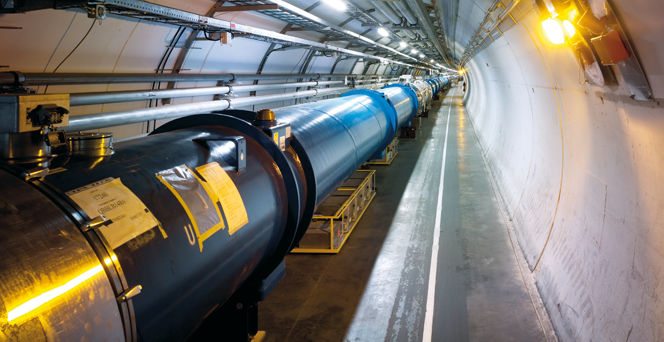URL: https://www.desy.de/e141261/e158573/e158694/index_eng.html
Breadcrumb Navigation

LHC experiments
ATLAS & CMS
It’s the world's most powerful accelerator and currently the biggest endeavour in particle physics: the Large Hadron Collider (LHC), a gigantic underground particle accelerator ring with a circumference of 27 kilometres at the CERN research centre near Geneva. The LHC accelerates protons to head-on collisions at record energies. Thus, it has the potential to generate completely new building blocks of matter – as in 2012, when it detected the long-sought Higgs boson. DESY is strongly involved in the LHC experiments ATLAS and CMS and provides large computing systems to deal with the flood of data produced by the LHC.
The current theory of particle physics – called the Standard Model – renders excellent services when describing processes in the microcosm. The Model contains many gaps, however. It raises questions that a comprehensive theory of the building blocks and forces in the universe should actually answer. What exactly are the unknown dark matter and dark energy, which make up 96 percent of the universe? Why is there more matter than antimatter in the cosmos? What did the universe look like in the first second after the big bang? Are there more than three dimensions of space?
Thanks to the record energies provided by the LHC, physicists hope to be able to answer a whole range of these questions. Using the LHC's high-energy particle collisions, the researchers effectively recreate the conditions that prevailed in the universe tiny fractions of a second after the big bang. The LHC thus acts like a time machine that enables the physicists to look back billions of years into the past to the very beginning of our universe.
The discovery of the Higgs boson
Two years after the start of data taking, the LHC experiments reported a spectacular success: In 2012, they announced the discovery of the Higgs particle, which physicists had sought for nearly 50 years. In the 1960s, the Scottish physicist Peter Higgs and others proposed a theory that explains how elementary particles acquire their mass. According to what became known as the Higgs mechanism, the cosmos is permeated by a special field that operates in a manner similar to honey when a spoon moves through it: It offers the particles due resistance and thereby makes them “heavy”. With the sensational discovery of the associated Higgs boson, the LHC experiments confirmed that the Higgs mechanism does indeed adequately describe the process by which elementary particles acquire their mass. In the fall of 2013, the Belgian physicist François Englert and Peter Higgs were awarded the Nobel Prize in Physics for their prediction.
The LHC researchers are now striving to precisely determine the properties of the new particle. They aim to find out whether it is exactly the Higgs boson predicted by the Standard Model, or whether it might have other properties that could hint at “new physics” beyond the Standard Model.
From SUSY particles to extra dimensions
The largest scientific machine in the world could also detect entirely different, so far merely speculative phenomena. One fascinating result would be the discovery of supersymmetric, or SUSY, particles. These could play a major role in the universe, as they could possibly explain what the mysterious dark matter in the universe is made of, which holds the galaxies together like invisible glue by virtue of its gravity. The LHC might also provide evidence that our world has more to offer than three dimensions of space and one of time. The cosmos could instead have significantly more dimensions. These would be so well hidden, however, that a superaccelerator like the LHC is required to even detect signs of their existence.
- Proton–proton storage ring at CERN near Geneva
- Can also be operated with heavy ions
- Circumference: 26.7 kilometres
- Location: 100 metres underground on the Franco-Swiss border
- Research operation: since 2009
- Maximum energy per proton beam: 7 teraelectronvolts (TeV)
- Experiments: ALICE, ATLAS, CMS, LHCb, LHCf, TOTEM


